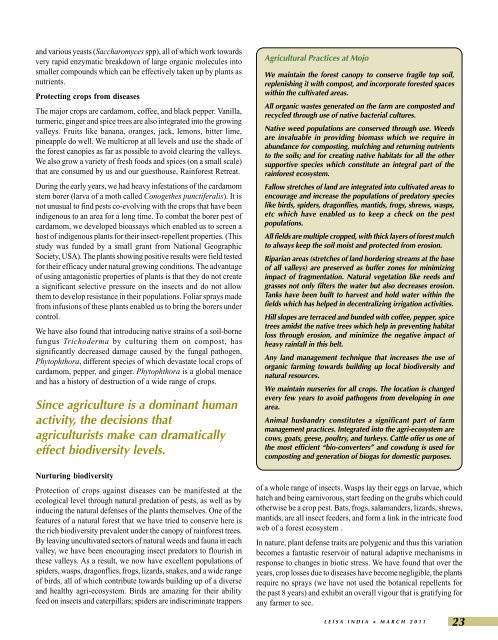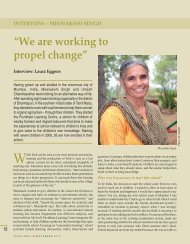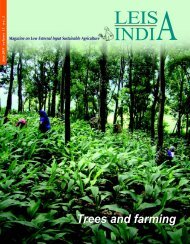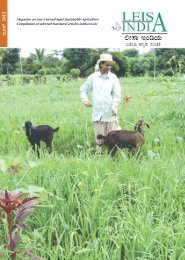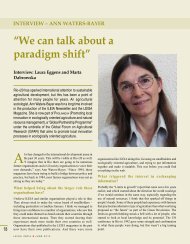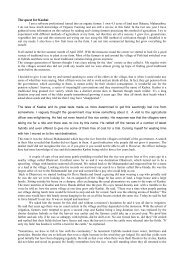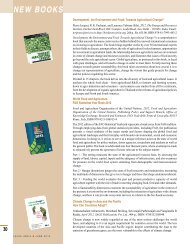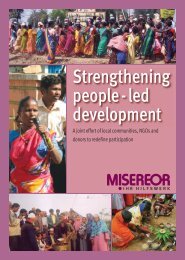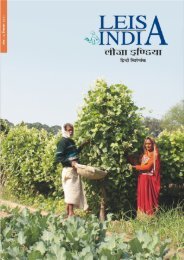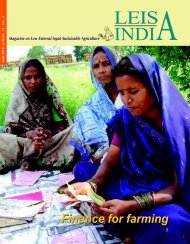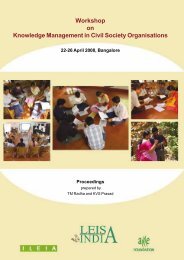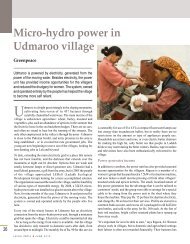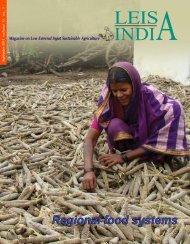Low external input sustainable agriculture - Leisa India
Low external input sustainable agriculture - Leisa India
Low external input sustainable agriculture - Leisa India
You also want an ePaper? Increase the reach of your titles
YUMPU automatically turns print PDFs into web optimized ePapers that Google loves.
and various yeasts (Saccharomyces spp), all of which work towardsvery rapid enzymatic breakdown of large organic molecules intosmaller compounds which can be effectively taken up by plants asnutrients.Protecting crops from diseasesThe major crops are cardamom, coffee, and black pepper. Vanilla,turmeric, ginger and spice trees are also integrated into the growingvalleys. Fruits like banana, oranges, jack, lemons, bitter lime,pineapple do well. We multicrop at all levels and use the shade ofthe forest canopies as far as possible to avoid clearing the valleys.We also grow a variety of fresh foods and spices (on a small scale)that are consumed by us and our guesthouse, Rainforest Retreat.During the early years, we had heavy infestations of the cardamomstem borer (larva of a moth called Conogethes punctiferalis). It isnot unusual to find pests co-evolving with the crops that have beenindigenous to an area for a long time. To combat the borer pest ofcardamom, we developed bioassays which enabled us to screen ahost of indigenous plants for their insect-repellent properties. (Thisstudy was funded by a small grant from National GeographicSociety, USA). The plants showing positive results were field testedfor their efficacy under natural growing conditions. The advantageof using antagonistic properties of plants is that they do not createa significant selective pressure on the insects and do not allowthem to develop resistance in their populations. Foliar sprays madefrom infusions of these plants enabled us to bring the borers undercontrol.We have also found that introducing native strains of a soil-bornefungus Trichoderma by culturing them on compost, hassignificantly decreased damage caused by the fungal pathogen,Phytophthora, different species of which devastate local crops ofcardamom, pepper, and ginger. Phytophthora is a global menaceand has a history of destruction of a wide range of crops.Since <strong>agriculture</strong> is a dominant humanactivity, the decisions thatagriculturists make can dramaticallyeffect biodiversity levels.Nurturing biodiversityProtection of crops against diseases can be manifested at theecological level through natural predation of pests, as well as byinducing the natural defenses of the plants themselves. One of thefeatures of a natural forest that we have tried to conserve here isthe rich biodiversity prevalent under the canopy of rainforest trees.By leaving uncultivated sectors of natural weeds and fauna in eachvalley, we have been encouraging insect predators to flourish inthese valleys. As a result, we now have excellent populations ofspiders, wasps, dragonflies, frogs, lizards, snakes, and a wide rangeof birds, all of which contribute towards building up of a diverseand healthy agri-ecosystem. Birds are amazing for their abilityfeed on insects and caterpillars; spiders are indiscriminate trappersAgricultural Practices at MojoWe maintain the forest canopy to conserve fragile top soil,replenishing it with compost, and incorporate forested spaceswithin the cultivated areas.All organic wastes generated on the farm are composted andrecycled through use of native bacterial cultures.Native weed populations are conserved through use. Weedsare invaluable in providing biomass which we require inabundance for composting, mulching and returning nutrientsto the soils; and for creating native habitats for all the othersupportive species which constitute an integral part of therainforest ecosystem.Fallow stretches of land are integrated into cultivated areas toencourage and increase the populations of predatory specieslike birds, spiders, dragonflies, mantids, frogs, shrews, wasps,etc which have enabled us to keep a check on the pestpopulations.All fields are multiple cropped, with thick layers of forest mulchto always keep the soil moist and protected from erosion.Riparian areas (stretches of land bordering streams at the baseof all valleys) are preserved as buffer zones for minimizingimpact of fragmentation. Natural vegetation like reeds andgrasses not only filters the water but also decreases erosion.Tanks have been built to harvest and hold water within thefields which has helped in decentralizing irrigation activities.Hill slopes are terraced and bunded with coffee, pepper, spicetrees amidst the native trees which help in preventing habitatloss through erosion, and minimize the negative impact ofheavy rainfall in this belt.Any land management technique that increases the use oforganic farming towards building up local biodiversity andnatural resources.We maintain nurseries for all crops. The location is changedevery few years to avoid pathogens from developing in onearea.Animal husbandry constitutes a significant part of farmmanagement practices. Integrated into the agri-ecosystem arecows, goats, geese, poultry, and turkeys. Cattle offer us one ofthe most efficient “bio-converters” and cowdung is used forcomposting and generation of biogas for domestic purposes.of a whole range of insects. Wasps lay their eggs on larvae, whichhatch and being carnivorous, start feeding on the grubs which couldotherwise be a crop pest. Bats, frogs, salamanders, lizards, shrews,mantids, are all insect feeders, and form a link in the intricate foodweb of a forest ecosystem .In nature, plant defense traits are polygenic and thus this variationbecomes a fantastic reservoir of natural adaptive mechanisms inresponse to changes in biotic stress. We have found that over theyears, crop losses due to diseases have become negligible, the plantsrequire no sprays (we have not used the botanical repellents forthe past 8 years) and exhibit an overall vigour that is gratifying forany farmer to see.LEISA INDIA • MARCH 201123


